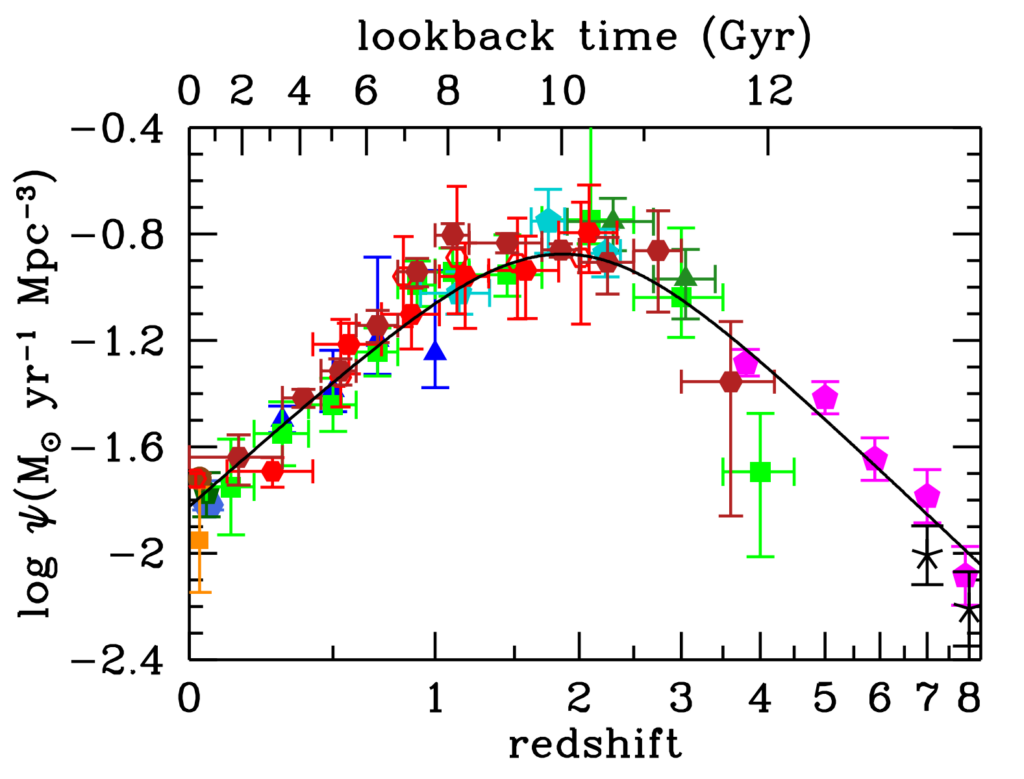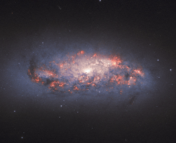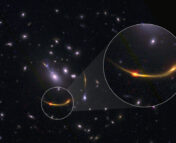Title: Normal, Dust-Obscured Galaxies in the Epoch of Reionization
Authors: Y. Fudamoto, P. A. Oesch, S. Schouws, M. Stefanon, R. Smit, et al.
First Author’s Institution: Research Institute for Science and Engineering, Waseda University, Tokyo, Japan
Status: Published in Nature [closed access], available on arXiv
As we look at objects increasingly far from Earth, we are able to study how our Universe looked further and further back in time, right back to its earliest stages. The first stars and galaxies formed about 100 million years after the Big Bang, and these radiated out huge amounts of energy. This illuminated the Universe for the very first time, which until this point had been permeated by dark clouds of hydrogen gas. However, the radiation produced by these early stars was so strong that it caused the atoms of hydrogen to split apart into protons and electrons, forming an ionised plasma. The subsequent period of the Universe, which occurred in the redshift range 6<z<15 (between 250 million and 1 billion years after the Big Bang), is known as the epoch of reionisation.
The development of new, powerful telescopes over the past few decades has allowed us to probe these ancient, distant periods of the Universe. Just 100 years ago, the Sombrero Galaxy was the furthest object whose distance had been measured by astronomers, at a redshift of z=0.003 (about 30 million light-years away). However, since the discovery of quasars in the 1950s, increasingly distant galaxies have been detected, more recently with telescopes such as the Hubble Space Telescope. This culminated in 2016, with the discovery of the galaxy GN-z11. This was found to have a redshift of z=11.1, meaning that we are seeing it as it was just 400 million years after the Big Bang, right in the middle of the reionisation epoch.
Today’s paper utilises this newfound ability to probe these distant periods of the Universe. In this work, the authors detect two new star-forming galaxies at redshifts of z=6.7 and z=7.4, during the epoch of reionisation. Although other galaxies have been found at this distance, these two stand out because of their unusual properties, which have important implications for future surveys of the high-redshift Universe.
Hiding behind a wall of dust
Many distant galaxies are detected at optical wavelengths; this corresponds to ultraviolet (UV) radiation that has been emitted by the galaxy, and then redshifted to optical wavelengths. Such galaxies are often starburst galaxies, which are very bright in UV light.
It is here where today’s paper starts. The authors use observations from the REBELS programme (Reionization-Era Bright Emission Line Survey), carried out by the ALMA observatory. This survey involves studying the brightness in radio waves of 40 UV-luminous high-redshift galaxies — a bright radio continuum is an indicator of galaxies containing large amounts of cosmic dust, which can dim the light produced by stars. However, the focus of this paper is actually two galaxies that aren’t part of the survey, but are near to two of these UV-luminous galaxies. These accidental discoveries are bright sources of radio waves that were detected by ALMA, but are completely absent from the original optical observations! One of these is shown below, in Figure 1.
This tells us that these two galaxies contain a lot of dust. In fact, they contain so much dust that the optical/UV light, which is produced by the stars, cannot be seen at all. Instead, we have two mysterious objects that can only be seen at radio wavelengths. Interestingly, these heavily dust-obscured galaxies have star formation rates in line with those of most star-forming galaxies, typically producing tens of stars per year. This is in stark contrast with most highly-dusty galaxies, which are often starburst galaxies with very high star formation rates, and can produce thousands of new stars every year.

Figure 1: Optical image of one galaxy from REBELS. Left panel shows the full image of this galaxy, which can be seen in the centre. Bottom-right panel shows a zoomed version of the same galaxy. Top-right panel shows the patch of sky where one of the two galaxies in today’s paper was found. Red contours show the position of the dust radio emission. Adapted from Figure 1 in today’s paper.
This tells us that these two galaxies contain a lot of dust. In fact, they contain so much dust that the optical/UV light, which is produced by the stars, cannot be seen at all. Instead, we have two mysterious objects that can only be seen at radio wavelengths. Interestingly, these heavily dust-obscured galaxies have star formation rates in line with those of most star-forming galaxies, typically producing tens of stars per year. This is in stark contrast with most highly-dusty galaxies, which are often starburst galaxies with very high star formation rates, and can produce thousands of new stars every year.
Two down, but how many to go?
A natural question to ask here is “Well, how many other galaxies like this are there?”. Previous work has found that heavily dust-obscured galaxies are not very common at high redshifts, but the detection of these two new galaxies appears to contradict this. In fact, it suggests that between 10% and 25% of all star formation at z>6 could take place in these dusty, but otherwise “normal”, galaxies. This measure is known as the “cosmic star formation rate density” (or SFRD), and is defined as the total mass of stars formed per year, per unit volume of the Universe. The SFRD is of great interest to astronomers, and is used to define different periods of the Universe’s history, such as cosmic noon (see Figure 2).

Figure 2: Graph showing how the cosmic star formation rate density (SFRD, vertical axis) changes with redshift. This quantity peaks at approximately z=2, known as “cosmic noon”. Adapted from Figure 9 in Madau & Dickinson (2014).
In order to more precisely estimate how common these galaxies are, surveys that can detect these incredibly faint objects are required, over much larger portions of the sky. Such a survey would be both expensive and technologically challenging, but would allow us a much deeper insight into how and where stars were formed in the earliest stages of the Universe.
Astrobite edited by Pratik Gandhi
Featured image credit: ESA, C. Carreau




